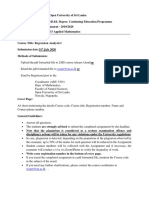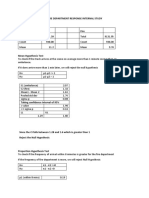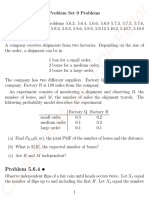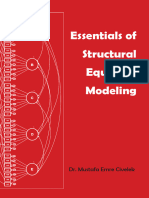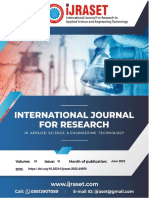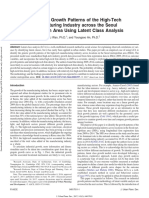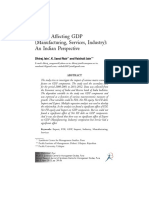The Applicability of Principal Component Analysis: A Review of The Nigeria Gross Domestic Products (GDP)
The Applicability of Principal Component Analysis: A Review of The Nigeria Gross Domestic Products (GDP)
Volume 9, Issue 9, September– 2024 International Journal of Innovative Science and Research Technology
ISSN No:-2456-2165 https://doi.org/10.38124/ijisrt/IJISRT24SEP250
The Applicability of Principal Component
Analysis: A Review of the Nigeria Gross
Domestic Products (GDP)
Adebukunola Olugbenga. S1 Peters Olatunji. S2
Department of Statistics, Department of Accountancy
D. S Adegbenro (ICT) Polytechnic, Itori – Ewekoro, D. S Adegbenro (ICT) Polytechnic, Itori – Ewekoro,
Ogun State, Nigeria Ogun State, Nigeria
Akinwunmi Oluwafemi. O3 Shorinmade Adewole. G4
Department of computer Science Department of Accountancy
D. S Adegbenro (ICT) Polytechnic, Itori – Ewekoro, D. S Adegbenro (ICT) Polytechnic, Itori – Ewekoro,
Ogun State, Nigeria Ogun State, Nigeria
Abstract:- In 2014, Nigeria was largest and fastest reached the peak in fourth quarter of 2014 with certain
growing economy in Africa, and this is determine by amount of about N24,205,863.34 million with a nominal
year on year Gross Domestic Product (GDP), which is GDP. Based on the Balance Trade by Kimberly 2018, the
the major tools use by the rest of the world to determine Nigerian GDP was worth 375.77 billion US dollars in 2017.
the capacity of a country. Furthermore National Bureau The GDP value of the Nigerian economy represents 0.61%
of Statistics (NBS) releases both quarterly and yearly of the world economy. GDP in Nigeria averaged 97.52 USD
growth of Nigeria GDP, while the data source in this Billion from 1960 until 2017. The Gross Domestic Product
project is from NBS, starting from 1980 to 2017. per capita of the economy was previously recorded as
Moreover the Nigeria GDP comprises many components. 2412.41 US dollars in 2017.
The major PCs use are Agriculture, Building and
Construction, Industry, Wholesale and Retail Trade, and Objectives of the Study
Services. It was observed that there is yearly growth in The objectives of this study are to determine the yearly
Nigeria gross domestic products due to increase in all growth of Nigeria Gross Domestics Products.
contributors factored components from 1980 to 2017,
Agriculture had the highest number activities to this per The Specific Objectives of this Study are:
capital income followed by Industry, Services, wholesale
and retail trade, and building and construction. Also the To examine the yearly growth pattern of the Nigeria
overall accumulated variance for the GDP for the GDP
studied period is 10.7 for a 56% coefficient of variation. To determine the contribution of each sector contributing
All the contributors (Agriculture, Industry,……) to national GDP for adequate policy making
maintained a positive correlation all through the period To predict yearly growth of Nigeria GDP
of study expect for Services that affect/shirk the GDP
along the year. Wholesales experienced the strongest Principal Component Analysis (PCA)
doling of taking care of the GDP with 98%, followed by This is a dimension tool that is used to reduce large
Building and Construction, industry and agriculture sets of variables to small sets and still retain most of the
with 86%, 78% and 6% respectively. However for information in the large sets. It is used to transforms
Nigeria to maintain the largest economy in Africa It will numbers of probably correlated variables into a smaller
strongly advice that the economy team should look number of uncorrelated variables known as principal
properly on agriculture and industry and if this two components.
increases certainly wholesale and retail trade with
building and construction will be affected positively Reason for Principal Component Analysis
while extended to services, therefore the GDP will also be The main reasons for the PCA includes
stabilise.
To reduces a larger number of variables to a smaller
I. INTRODUCTION number of factors
To choose a fraction of variables from a whole, based on
Background to the Study the original variables that have the highest correlations
Nigeria become the fastest growing economy in Africa with the principal component.
in 2012 by the Rebasing (GDP) released from the bulletin
published by the National Bureau of Statistics (NBS) which
make Nigeria to become the largest economy in Africa and
IJISRT24SEP250 www.ijisrt.com 1005
Volume 9, Issue 9, September– 2024 International Journal of Innovative Science and Research Technology
ISSN No:-2456-2165 https://doi.org/10.38124/ijisrt/IJISRT24SEP250
Gross Domestic Product (GDP) II. METHODOLOGY
The GDP comprises of the total values of goods and
services produced by the country. However indicates if what A secondary source of data was employed in this work
is produced is owned by the citizens or foreign-owned extracted from the Bulletin of the National Bureau of
companies. It is also the monetary value of all finished Statistics. The Principal Component Analysis (PCA) was
goods and services produced by a country within a specific adopted for the analysis, the major PCs use are GDP,
time period. it is usually computed within a year. It involves Agriculture, Building and Construction, Industry, Wholesale
in total all the private and public consumption, government and Retail Trade, and Services.
outlays, investments, private inventories, paid-in
construction costs and the foreign balance of III. RESULTS AND DISCUSSION
trade (exports are added, imports are subtracted). Gross
National Product (GNP), measures the total production of A. Results
the citizens of a country, and of those living abroad, such The Gross Domestic Product is made up some
that domestic production by foreigners is excluded. GDP is contributing factors of which are Agriculture, Industry,
used as an instrument to measure the state of the economy of Building and Construction, Wholesales and retails trade and
a country, also to determine country's standard of living. Services. The time plots adopted zigzag (unidirectional) and
uncategorized form due to the factoring nature as indicated
below in fig.1 to fig. 6.
Fig 1 (A Plot showing a Zigzag Direction of GDP over Time)
Fig 2 (A Plot showing a Zigzag Direction of Industry over Time)
IJISRT24SEP250 www.ijisrt.com 1006
Volume 9, Issue 9, September– 2024 International Journal of Innovative Science and Research Technology
ISSN No:-2456-2165 https://doi.org/10.38124/ijisrt/IJISRT24SEP250
Fig 3 (A Plot showing a Zigzag Direction of Building and Construction over Time)
Fig 4 (A Plot showing a Zigzag Direction of Agriculture over Time)
Fig 5 (A Plot showing a Zigzag Direction of Wholesale and Retail over Time)
IJISRT24SEP250 www.ijisrt.com 1007
Volume 9, Issue 9, September– 2024 International Journal of Innovative Science and Research Technology
ISSN No:-2456-2165 https://doi.org/10.38124/ijisrt/IJISRT24SEP250
Fig 6 (A Plot showing a Zigzag Direction of Services over Time)
From the histograms of the contributors, it is note that all the contributors are factored components due to their increasing
factor from 1981 to 2017 to the Nigeria GDP as it is shown below in fig 7 to 12.
Fig 7 (Histogram showing the Contribution of the GDP over Time)
Fig 8 (Histogram showing the Contribution of the Industry over Time)
IJISRT24SEP250 www.ijisrt.com 1008
Volume 9, Issue 9, September– 2024 International Journal of Innovative Science and Research Technology
ISSN No:-2456-2165 https://doi.org/10.38124/ijisrt/IJISRT24SEP250
Fig 9 (Histogram showing the Contribution of the Building and Construction over Time)
Fig 10 (Histogram showing the Contribution of Agriculture over Time)
Fig 11 (Histogram showing the Contribution of wholesale and Retail Trade over Time)
IJISRT24SEP250 www.ijisrt.com 1009
Volume 9, Issue 9, September– 2024 International Journal of Innovative Science and Research Technology
ISSN No:-2456-2165 https://doi.org/10.38124/ijisrt/IJISRT24SEP250
Fig 12 (Histogram showing the Contribution of Services over Time)
Q–Q (Quantile-Quantile) Plot below, shows the Contribution Factors are Normal q-q Plot.
Fig 13 Q–Q (Quantile-Quantile) Plot shows the Contribution Factors are Normal q-q Plot
Fig 14 Q–Q (Quantile-Quantile) Plot shows the Contribution Factors are Normal q-q Plot
IJISRT24SEP250 www.ijisrt.com 1010
Volume 9, Issue 9, September– 2024 International Journal of Innovative Science and Research Technology
ISSN No:-2456-2165 https://doi.org/10.38124/ijisrt/IJISRT24SEP250
Fig 15 Q–Q (Quantile-Quantile) Plot shows the Contribution Factors are Normal q-q Plot
Fig 16 Q–Q (Quantile-Quantile) Plot shows the Contribution Factors are Normal q-q Plot
Fig 17 Q–Q (Quantile-Quantile) Plot shows the Contribution Factors are Normal q-q Plot
IJISRT24SEP250 www.ijisrt.com 1011
Volume 9, Issue 9, September– 2024 International Journal of Innovative Science and Research Technology
ISSN No:-2456-2165 https://doi.org/10.38124/ijisrt/IJISRT24SEP250
Agriculture had the highest number activities to this for SERVICES that affect/shirk the GDP along the year.
per capital income followed by Industry, Services, Wholesales experienced the strongest doling of taking care
wholesales and building. It is to be noted that factored series of the GDP with 98%, followed by BC, industry and agric
are more suitable PCA than that of time series models. This with 86%, 78% and 6% respectively, and -6% shirking by
factored certainty was justified by the decreasing variance of Services.
the GDP from 1981 to 2017. It connotes that the variation at
the beginning of 1981 that the GDP and its contributors are Correlation Matrix:
lower and far apart from the immediate past one, the
deviation in variation was larger. That is why all the , 𝐴𝑔𝑟𝑖𝑐𝑢𝑙𝑡𝑢𝑟𝑒 𝑖𝑛𝑑𝑢𝑠𝑡𝑟𝑦 𝑏𝑢𝑖𝑙𝑑𝑖𝑛𝑔 𝑤𝑟𝑡 𝐺𝐷𝑃
histograms and QQ plots maintained and suggested a single
. . . . . .
increasing flow of trend expect for services that experienced 𝐴𝑔𝑟𝑖𝑐𝑢𝑙𝑡𝑢𝑟𝑒 1.00 0.64 0.490.83 0. .80 0.93
a structural break towards last three years. 𝐼𝑛𝑑𝑢𝑠𝑡𝑟𝑦 0.76 1.00 0.760.54 −0.92 0.01
𝐵𝑢𝑖𝑙𝑑𝑖𝑛𝑔/𝐶 0.89 0.86 1.000.62 0.73 0.48
Correlation Matrix and Descriptive Interpretation 𝑊𝑅𝑇 0.40 0.92 0.841.00 0.72 0.40
The overall accumulated variance for the GDP for the 𝑆𝑒𝑟𝑣 𝑖𝑐𝑒𝑠 0.88 0.39 0.770.79 1.00 −0.49
studied period is 10.7 for a 56% coefficient of variation. All 𝐺𝐷𝑃 (0.06 0.78 0.860.98 −0.24 1.00 )
the contributors (Agriculture, Industry) maintained a
positive correlation all through the period of study expect
Fig 18 Correlation Matrix
Standard deviations (1, .., p=6):
2.33372393, 1.09623192, 0.72182793, 0.67615707, 0.49697892, 0.27157857
Rotation (n x k) = (5 x 5):
𝐴𝑔𝑟𝑖𝑐𝑢𝑙𝑡𝑢𝑟𝑒 PC1 PC2 PC3 PC4 PC5
0.47734940 0.98901324 0.05672682 0.979472237 0.406389
𝐼𝑛𝑑𝑢𝑠𝑡𝑟𝑦
0.75629982 −0.84085003 0.52905782 −0.30280380 0.038019
𝐵𝑢𝑖𝑙𝑑𝑖𝑛𝑔/𝐶 .
0.33224949 0.93018727 0.84671814 0.50898677 0.06782880
𝑊𝑅𝑇 −0.37686180 0.0364668 −0.4172022 0.76991028 0.503674682
𝑆𝑒𝑟𝑣𝑖𝑐𝑒𝑠 ( 0.41792790 −0.0630886 −0.56024367 0.390190939 0.308588990 )
PCA Interpretation Whereas the diverging contributor that happened to be the
The factor contribution of services, and WRT with wheeling contributor at the beginning of the studied period
cumulative proportions of 0.98258 and 0.94754 happened to is Agric with the smallest Cumulative Proportion of 0.6372
be the converging components of interest with minimum and Proportion of Variance to be 0.6372. The linear
Proportion of Variances 0.06531 and 0.03504 respectively. combination (that is the eigenvalues of each of the
Building/Construction and Industry are the swingy individual components are.
maintained components that are balance wheeling
components with cumulative proportions 0.88223 and
0.8078 with reduced variation of 0.07443 and 0.1706.
IJISRT24SEP250 www.ijisrt.com 1012
Volume 9, Issue 9, September– 2024 International Journal of Innovative Science and Research Technology
ISSN No:-2456-2165 https://doi.org/10.38124/ijisrt/IJISRT24SEP250
Components of PC (%s): V. CONCLUSION
There is yearly growth in Nigeria gross domestic
products due to increase in all contributors factored
components from 1980 to 2017, Agriculture had the highest
number activities to this per capital income followed by
Industry, Services, wholesale and retail trade, and building
and construction.
The Linear Combination for the First Principal Also the overall accumulated variance for the GDP for
Component is: the studied period is 10.7 for a 56% coefficient of variation.
All the contributors (Agriculture, Industry) maintained a
positive correlation all through the period of study expect
for SERVICES that affect/shirk the GDP along the year.
Wholesales experienced the strongest doling of taking care
Prediction of the GDP with 98%, followed by Building and
Construction, industry and agriculture with 86%, 78% and
6% respectively.
RECOMMENDATION
For Nigeria to maintain the largest economy in Africa I will
strongly advice the economy team should look properly on
agriculture and industry if this two increases certainly
wholesale and retail trade with building and construction
It is to be noted that the prediction of the in-sample of will be affected positively while extended to services,
2017 is closer to the actual recorded observation with therefore the GDP will also be stabilise
(24,465.09 - 23,952.55) = 512.54 residue for Agriculture,
REFFERENCES
(8,520.11 - 7,927.90) = 592.21 for residue for industry,
[1]. Beltrami, E. (1873). Sullefunzionibilineari.Giornale
(702.99 - 667.92) = 35.07 residue for BC, di Mathematiche diBattaglini, 11, 98–106.
[2]. Bryant, E.H. and Atchley, W.R. (1975).Multivariate
(23,221.65 - 21,895.09) = 1,326.56 residue for WRT, Statistical Methods: Within Group
Covariation.Stroudsberg: Halsted Press.Fisher and
(5,983.00 - 5,129.34) = 853.66 residue for services and Mackenzie (1923)
[3]. Girshick, M.A. (1936). Principal components.J.
(45,490.52- 44,093.09) = 1397.43 for GDP Amer. Statist. Assoc., 31,519–528.
[4]. Girshick, M.A. (1939). On the sampling theory of
Predict (gdp_pca) [,1] roots of determinantal equations.Ann. Math.
Statist.,10, 203–224
[5]. Hadi, A.S. and Ling, R.F. (1998).Some cautionary
notes on the use ofprincipal components
regression.Amer. Statistician, 52, 15–19.
[6]. Hall, P., Poskitt, D.S., and Presnell, B. (2001).A
IV. SUMMARY functional data-analyticapproach to signal
discrimination.Technometrics, 43, 1–9.
In 2014, Nigeria was largest and fastest growing [7]. Hamilton, J.D. (1994). Time Series Analysis.
economy in Africa, and this is determine by year on year Princeton: Princeton UniversityPress.
Gross Domestic Product (GDP), which is the major tools use [8]. Hotelling, H. (1933). Analysis of a complex of
by the rest of the world to determine the growth of a statistical variables into principal components. J.
country’s economy. Furthermore National Bureau of Educ. Psychol., 24, 417–441, 498–520.
Statistics (NBS) releases both quarterly and yearly growth of [9]. Hotelling, H. (1936). Simplified calculation of
Nigeria GDP, while the data source in this project is from principal components. Psychometrika, 1, 27–35.
NBS, starting from 1980 to 2017. Moreover the Nigeria [10]. Hotelling, H. (1957). The relations of the newer
GDP, comprises many component therefore the Principal multivariate statistical
Component Analysis (PCA) was adopted for the analysis, [11]. https//;www.bea.gov
the major PCs use are Agriculture, Building and [12]. https//;www.thebalance.com
Construction, Industry, Wholesale and Retail Trade, and [13]. https//www.cia.gov/library/publication
Services [14]. https;//tradingeconomics.com/Nigeria/gdp
[15]. https;www.investopedia.com
IJISRT24SEP250 www.ijisrt.com 1013
Volume 9, Issue 9, September– 2024 International Journal of Innovative Science and Research Technology
ISSN No:-2456-2165 https://doi.org/10.38124/ijisrt/IJISRT24SEP250
[16]. I.T JOLLFFE 2001. Principal Component Analyses
Second edition springlerstatitistics series, Jeffers,
J.N.R. (1962). Principal component analysis of
designed experiment. Statistician, 12, 230–242.
[17]. Jeffers, J.N.R. (1967). Two case studies in the
application of principal component analysis. Appl.
Statist., 16, 225–236. Jordan (1874)
[18]. Mori, Y., Tanaka, Y. and Tarumi, T. (1998).
Principal component analysis based on a subset of
variables for qualitative data. In Data Science,
[19]. National Bureau of Statistics NBS Nigeria Gross
Domestic Product Report quarter 1
[20]. National Bureau of Statistics NBS Nigeria Gross
Domestic Product Report 2017 Full report
[21]. National Bureau of Statistics NBS Nigeria Gross
Domestic Product Report 2016 Full report
[22]. National Bureau of Statistics NBS Nigeria Gross
Domestic Product Report 2015 Full report
[23]. National Bureau of Statistics NBS Nigeria Gross
Domestic Product Report 2014 Full report
[24]. National Bureau of Statistics NBS Nigeria Gross
Domestic Product Report 1980 – 2013
[25]. Preisendorfer, R.W. and Mobley, C.D.
(1988).Principal ComponentAnalysis
[26]. Rao, C.R. (1964). The use and interpretation of
principal component analysis in applied research.
Sankhya A, 26, 329–358.

